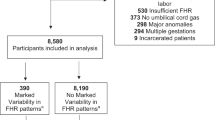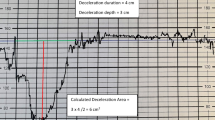Abstract
Purposes
To correlate between umbilical artery cord blood lactate and acid–base status with intrapartum fetal heart rate monitoring, and to measure the reliability of umbilical cord blood lactate for prediction of early neonatal outcome.
Methods
Sixty-six participants with intrapartum abnormal fetal heart rate monitoring and 60 participants with normal intrapartum recordings were recruited. The abnormal recordings included late onset, atypical variable and simple variable decelerations. After delivery, the arterial cord blood lactate, pH, actual base excess (ABE), and Apgar score were measured in all participants.
Results
There was significant inverse correlation between cord lactate and pH and ABE in all participants (correlation coefficient = −0.7, p < 0.0001). The cord lactate was significantly higher in the late onset and atypical variable decelerations groups compared to control (p < 0.0001). There was no significant correlation between the Apgar score and blood lactate in all groups; however, the sensitivity and specificity of cord lactate to predict low score at 5 min were higher in comparison to cord pH.
Conclusions
Umbilical cord blood lactate is a reliable marker for intrapartum fetal asphyxia compared to cord acid–base status with better prediction for newborns with low Apgar score.

Similar content being viewed by others
References
Vintzileos AM, Nochimson DJ, Antsaklis A, Varvarigos I, Guzman I, Knuppel RA (1995) Comparison of intrapartum electronic fetal heart monitoring versus intermittent auscultation in detecting fetal acidemia at birth. Am J Obstet Gynecol 173:1021–1024
Alfirevic Z, Devane D, Gyte GML (2006) Continuous cardiotocography (CTG) as a form of electronic fetal monitoring (EFM) for fetal assessment during labour (Cochrane Review). Cochrane Database Syst Rev (3):CD006066
Bretscher J, Saling E (1967) pH values in the human fetus during labor. Am J Obstet Gynecol 97:906–911
Westgren M, Kuger K, Ek S, Grunevald C, Kublickas M, Naka K et al (1998) Lactate compared with pH analysis at fetal scalp blood sampling: a prospective randomised study. Br J Obstet Gynaecol 105:29–33
Tuffnell D, Haw WL, Wilkinson K (2006) How long does a fetal scalp blood sample take? BJOG 113:332–334
Kruger K, Kublickas M, Westgren M (1998) Lactate in scalp and cord blood from fetuses with ominous fetal heart rate patterns. Obstet Gynecol 92:918–922
Nordstrom L, Malcus P, Chua S, Shimojo N, Arulkumaran S (1998) Lactate and acid–base balance at delivery in relation to cardiotocography and T/QRS ratios in the second stage of labour. Eur J Obstet Gynecol Reprod Biol 76:157–160
Borruto F, Comparetto C, Wegher E, Treisser A (2006) Screening of fetal distress by assessment of umbilical cord lactate. Clin Exp Obstet Gynecol 33:219–222
Schimojo N, Naka K, Uenoyama H, Hamamoto K, Yoshioka K, Okuda K (1993) Electrochemical assay system with single-use electrode strip for measuring lactate in whole blood. Clin Chem 39:2312–2314
Gjerris AC, Jensen JS, Jørgensen JS, Bergholt T, Nickelsen C (2008) Umbilical cord blood lactate: a valuable tool in the assessment of fetal metabolic acidosis. Eur J Obstet Gynecol Reprod Biol 139:16–20
Chanrachakul B, Chua S, Nordstrom L, Yam J, Arulkumaran S (1999) Umbilical artery blood gas and lactate in healthy newborns. J Med Assoc Thai 82:388–393
Royal College of Obstetricians and Gynaecologists (RCOG) (2001) Use of electronic fetal monitoring. The use and interpretation of cardiotocography in intrapartum fetal surveillance. Evidence-based clinical guideline number 8. Royal College of Obstetricians and Gynaecologists Press, London
American College of Obstetricians and Gynaecologists (ACOG) Practice Bulletin number 106 (2009) Intrapartum fetal heart rate monitoring: nomenclature, interpretation, and general management principles. Obstet Gynecol 114:192–202
Westgren M, Divon M, Horal M, Ingemarsson I, Kublickas M, Shimojo N et al (1995) Routine measurements of umbilical artery lactate levels in the prediction of perinatal outcome. Am J Obstet Gynecol 173:1416–1422
Nordstrom L (2004) Fetal scalp and cord blood lactate. Best Pract Res Clin Obstet Gynaecol 18:467–476
Nordstorm L, Ingemarsson I, Western M (1996) Fetal monitoring with lactate. Baillieres Clin Obstet Gynaecol 10:225–242
Wiberg N, Källén K, Olofsson P (2006) Base deficit estimation in umbilical cord blood is influenced by gestational age, choice of fetal fluid compartment, and algorithm for calculation. Am J Obstet Gynecol 195:1651–1656
Andres RL, Saade G, Gilstrap LC, Wilkins I, Witlin A, Zlatnik F et al (1999) Association between umbilical blood gas parameters and neonatal morbidity and death in neonates with pathologic fetal acidemia. Am J Obstet Gynecol 181:867–871
East CE, Colditz PB, Begg LM, Brennecke SP (2002) Update on intrapartum fetal pulse oximetry. Aust N Z J Obstet Gynaecol 42:119–124
Nordstrom L, Lngemarsson I, Kublickas M, Persson B, Shimojo N, Westgren M (1995) Scalp blood lactate—a new test strip method for monitoring fetal well-being in labour. Br J Obstet Gynaecol 102:894–899
Heinis AM, Spaanderman ME, Gunnewiek JM, Lotgering FK (2011) Scalp blood lactate for intra-partum assessment of fetal metabolic acidosis. Acta Obstet Gynecol Scand 90:1107–1114
Biringer K, Danko J, Dókus K, Mat’asová K, Zibolen M, Pullmann R (2011) Biochemical aspects of fetal hypoxia. Ceska Gynaecol 76:285–291
Nelson KB, Ellenberg JH (1981) Apgar scores as predictors of chronic neurologic disability. Pediatrics 68:36–44
Sykes GS, Molloy PM, Johnson P et al (1982) Do Apgar scores indicate asphyxia? Lancet 1:494–496
Williams Bode, Arulkumaran S (2004) Cardiotocography and medicolegal issues. Best Pract Res Clin Obstet Gynaecol 18:457–466
Wiberg N, Källén K, Herbst A, Olofsson P (2010) Relation between umbilical cord blood pH, base deficit, lactate, 5-minute Apgar score and development of hypoxic ischemic encephalopathy. Acta Obstet Gynecol Scand 89:1263–1269
Kruger K, Hallberg B, Blennow M et al (1999) Predictive value of fetal scalp blood lactate concentration and pH as marker for neurologic disability. Am J Obstet Gynecol 181:1072–1078
Acknowledgments
The author acknowledges Dr. Manal M. Kamal, MD, Physiology Department, Assiut University for her assistance in measurement of umbilical blood lactate and Dr. Maher M. Ahmad, MD, Professor of Pediatrics, Assiut University for his kind supervision to assess the neonates by staff in-charge.
Conflict of interest
The author has no conflicts of interest to declare.
Author information
Authors and Affiliations
Corresponding author
Rights and permissions
About this article
Cite this article
Hamed, H.O. Intrapartum fetal asphyxia: study of umbilical cord blood lactate in relation to fetal heart rate patterns. Arch Gynecol Obstet 287, 1067–1073 (2013). https://doi.org/10.1007/s00404-012-2694-7
Received:
Accepted:
Published:
Issue Date:
DOI: https://doi.org/10.1007/s00404-012-2694-7




